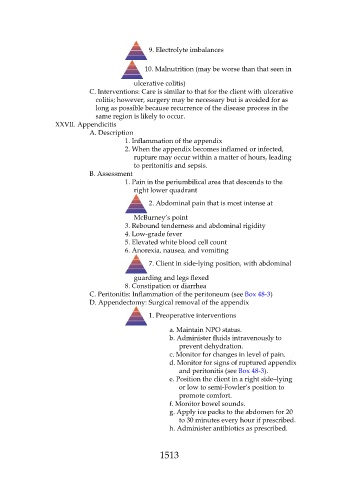Page 1513 - Saunders Comprehensive Review For NCLEX-RN
P. 1513
9. Electrolyte imbalances
10. Malnutrition (may be worse than that seen in
ulcerative colitis)
C. Interventions: Care is similar to that for the client with ulcerative
colitis; however, surgery may be necessary but is avoided for as
long as possible because recurrence of the disease process in the
same region is likely to occur.
XXVII. Appendicitis
A. Description
1. Inflammation of the appendix
2. When the appendix becomes inflamed or infected,
rupture may occur within a matter of hours, leading
to peritonitis and sepsis.
B. Assessment
1. Pain in the periumbilical area that descends to the
right lower quadrant
2. Abdominal pain that is most intense at
McBurney’s point
3. Rebound tenderness and abdominal rigidity
4. Low-grade fever
5. Elevated white blood cell count
6. Anorexia, nausea, and vomiting
7. Client in side-lying position, with abdominal
guarding and legs flexed
8. Constipation or diarrhea
C. Peritonitis: Inflammation of the peritoneum (see Box 48-3)
D. Appendectomy: Surgical removal of the appendix
1. Preoperative interventions
a. Maintain NPO status.
b. Administer fluids intravenously to
prevent dehydration.
c. Monitor for changes in level of pain.
d. Monitor for signs of ruptured appendix
and peritonitis (see Box 48-3).
e. Position the client in a right side–lying
or low to semi-Fowler’s position to
promote comfort.
f. Monitor bowel sounds.
g. Apply ice packs to the abdomen for 20
to 30 minutes every hour if prescribed.
h. Administer antibiotics as prescribed.
1513

